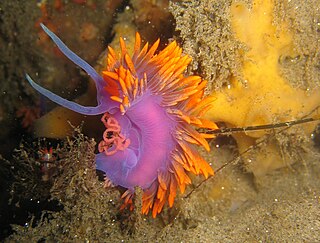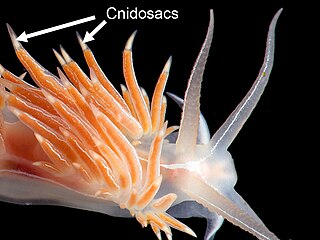
Trinchesia speciosa, common name the "candy nudibranch", is a species of sea slug, an aeolid nudibranch, a marine gastropod mollusc in the family Trinchesiidae.

The frilled nudibranch, Leminda millecra, is a species of metarminid nudibranch, and is only found in South Africa. It is a marine gastropod mollusc in the family Charcotiidae.
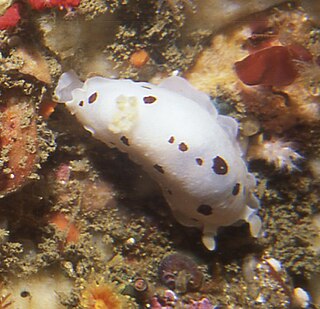
The chocolate-chip nudibranch, Aphelodoris sp. 1, is an undescribed species of dorid nudibranch as designated by Gosliner, 1987. It is a marine gastropod mollusc in the family Dorididae. As of November 2009, it was undescribed by academics.
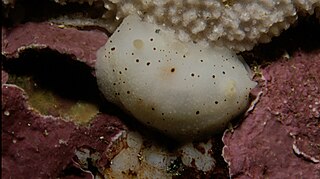
The brown-dotted nudibranch, Cadlina sp.2, as designated by Gosliner, 1987, is a species of colourful sea slug, a dorid nudibranch. It is a marine gastropod mollusc in the family Cadlinidae.
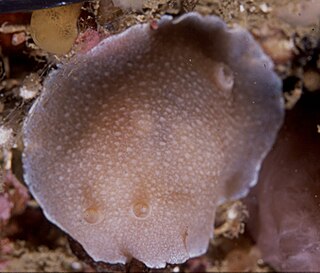
The white-spotted nudibranch is a species of sea slug, a dorid nudibranch. It is a marine gastropod mollusc in the family Dendrodorididae.
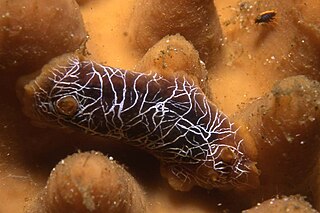
The scribbled nudibranch is a species of sea slug, a dorid nudibranch. It is a marine gastropod mollusc in the family Dendrodorididae.

The crowned nudibranch is a species of dorid nudibranch. It is a marine gastropod mollusc in the family Polyceridae.
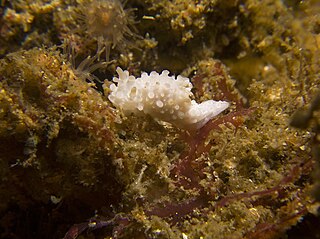
The knobbly nudibranch, Aegires ninguis, is a species of dorid nudibranch. It is a marine gastropod mollusc in the family Aegiridae.
Acanthodoris planca is a species of dorid nudibranch. It is a marine gastropod mollusc in the family Onchidorididae.
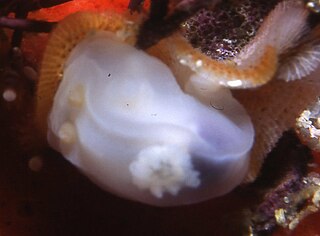
The ghost nudibranch, Lecithophorus capensis, is a species of dorid nudibranch, and is only found in South Africa. It is a marine gastropod mollusc in the family Polyceridae. It is the sole species of the genus Lecithophorus.
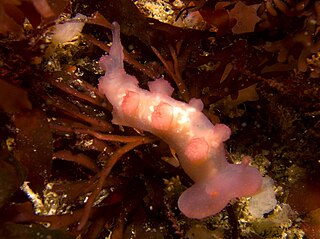
Melibe rosea, the cowled nudibranch, is a species of sea slug, a dendronotid nudibranch, a marine gastropod mollusc in the family Tethydidae.

The brush nudibranch, Tritonia sp. 2, as designated by Gosliner, 1987, is a species of dendronotid nudibranch. It is a marine gastropod mollusc in the family Tritoniidae. As at November 2009, it remained undescribed by science.

The white-ridged nudibranch, Dermatobranchus sp. 1, as designated by Gosliner, 1987, is a species of nudibranch. It is a marine gastropod mollusc in the family Arminidae. As at November 2009, it remained undescribed by science.

The brown ridged nudibranch, Dermatobranchus sp. 4, as designated by Gosliner, 1987, is a species of nudibranch. It is a marine gastropod mollusc in the family Arminidae. As at November 2009, it remained undescribed by science.

Janolus capensis, the Cape silvertip nudibranch, is a beautiful species of nudibranch, or sea slug. It is a marine gastropod mollusc in the family Proctonotidae.

Janolus longidentatus, the medallion silvertip nudibranch, is a spectacular-looking species of nudibranch, or sea slug. It is a marine gastropod mollusc in the family Proctonotidae.

The candelabra nudibranch, is a species of sea slug or nudibranch, a marine gastropod mollusc in the family Eubranchidae. It is an aeolid nudibranch, which is known to occur off the South African coast. As of August 2015, it remained undescribed by science.
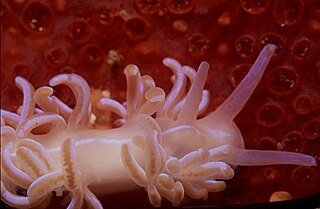
Phyllodesmium horridum, the coral nudibranch, is a species of sea slug, specifically an aeolid nudibranch. It is a marine gastropod mollusc in the family Facelinidae.
Amanda is a genus of sea slugs, specifically of aeolid nudibranchs. They are marine gastropod molluscs in the family Facelinidae.
The fireworks nudibranch, Eubranchus sp. 4, as designated by Zsilavecz, 2007, is a species of sea slug or nudibranch, a marine gastropod mollusc in the family Eubranchidae. It is an aeolid nudibranch, which is known to occur off the South African coast. As at August 2010, it remained undescribed by science.

